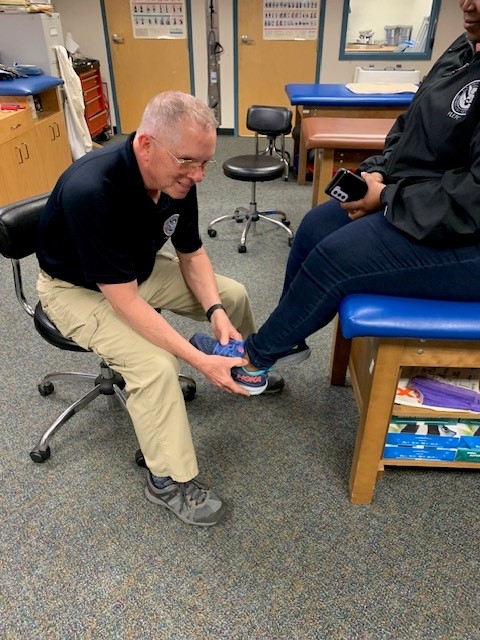
By Rob Gwin, FLETC OPA

Alexander “Al” Hawkins.
Alexander “Al” Hawkins has been an Athletic Trainer/Instructor with the Federal Law Enforcement Training Centers’ (FLETC) Charleston, SC training delivery point for 23 years. He is a member of the National Athletic Trainers’ Association (NATA), holds a license to practice from the State of South Carolina, and is a certified Emergency Medical Technician (EMT). Hawkins is clearly an expert in the field, and well qualified for his Athletic Trainer duties.
Given the dynamic nature of FLETC training, students may occasionally get injured. These injuries can range from a sprained ankle to back injuries or minor head trauma. Athletic Trainers like Hawkins are usually the first to see and treat them.
“We work in conjunction with the Health Unit to provide first aid care, and rehabilitation of injuries to students and staff.” Says Hawkins.
“We [Athletic Trainers] are kind of the ‘Jacks-of-all-Trades’ of the medical world.” He explains that not only are Athletic Trainers usually the first to see a student’s injury, but they also evaluate it, conduct immediate care, recommend treatment, supervise rehabilitation, and facilitate follow-up assessments.
Hawkins says “The range that we fall under, goes from prevention, to return to training, and our skill sets range from taking care of a blister to a spinal injury. We see it all.”

The goal is to keep students in training rather than send them home because of a treatable injury. “Sometimes,” he says, “they’re reluctant to tell us about it.”
This may be because some students believe that an injury requiring treatment may end their training and possibly their careers. Hawkins says that isn’t always the case. “We gain their trust and make sure they understand we’re here to keep them in training and I think we do a pretty good job. It’s rare that someone has to go home because of an injury.”
Additionally, there is an educational and prevention piece to all that Athletic Trainers provide. Hawkins says that he always ensures that his patients understand that fitness, nutrition, and safety all play a part in injury prevention.
“I tell them [students] this is an educational setting, this is a learning session, and they must learn about their injury, how to care for their injury, and how to help prevent getting injured again. Just because the pain goes away doesn’t mean they’re done.”
Not only does Mr. Hawkins provide care and education, but he also truly cares about the students’ wellbeing and future careers.
“The best part,” he said with a smile, “is seeing the light come on when they get to go back to training and they realize that they can keep doing what they’re doing, that they’re not done.”
Hawkins knows trust is a big part of helping the recovery process and he makes sure his patients understand that as well. “When they get that trust and know that I can help them, that is the best part.”
“I love my job.” he says, “I love my job because I get to work with law enforcement. There’s no better group to work with than this.”
Hawkins is also a self-admitted “chocoholic” and those who get to know him find that out quickly. He says he doesn’t always hear from patients after they leave FLETC, but a few of them have made sure to let him know he made an impression. “They drop off chocolates on my desk on their way out of town saying, ‘thank you,’ and that’s when I know we’re making a difference.”

